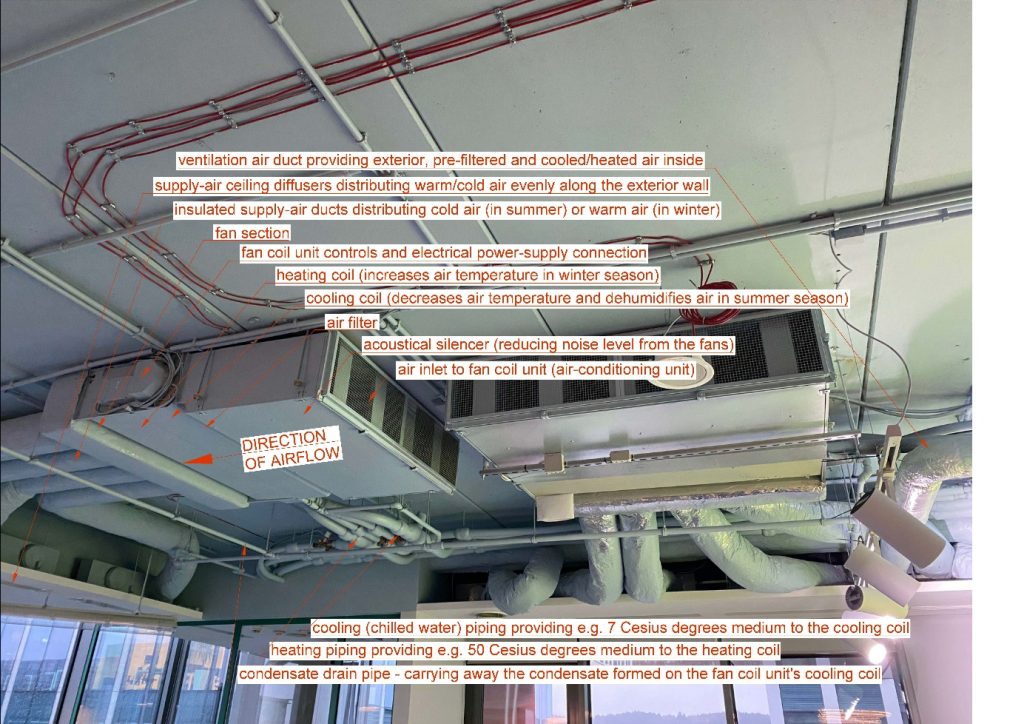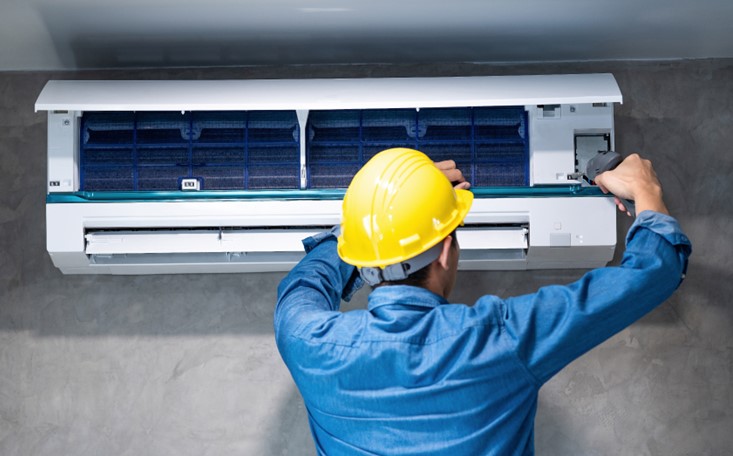Have you ever wondered what keeps your home comfortably warm in winter and refreshingly cool during summer? How do large buildings maintain excellent air quality, temperature, and humidity, regardless of outside weather? The answer lies in the often-overlooked yet essential world of Heating, Ventilation, and Air Conditioning (HVAC).
HVAC is more than just a technology; it’s an integral part of our lives, silently working in the background to ensure our comfort and health. But what exactly goes into this technology that we so often take for granted? How has it evolved to meet the demands of modern living?
The ubiquity of HVAC Systems
HVAC systems are everywhere, though we often don’t notice them. They’re in our homes, controlling the climate to make our living spaces more comfortable. In offices and commercial buildings, they regulate temperature and air quality, directly impacting productivity and well-being[i]. Critical facilities like hospitals play a vital role in keeping environments sterile and safe.
Consider a hot summer day when you walk into a cool, air-conditioned store. That immediate relief you feel is thanks to an HVAC system. Or think about the consistent temperature in museums that protect priceless artifacts from damage. These are just a few examples of how HVAC systems touch every aspect of our lives.
“Ventilation vs. Air-Conditioning: are they really the same?”
While often confused, ventilation and air-conditioning serve different purposes in indoor climate control. At its core, ventilation focuses on maintaining air quality by providing fresh outdoor air and removing stale indoor, polluted air. This essential process, facilitated by several HVAC system components like air-handling units, ductwork systems, and exhaust fans, ensures a steady flow of oxygen and prevents the buildup of pollutants like carbon dioxide.
In contrast, air-conditioning goes beyond airflow, regulating temperature, humidity, and air purity to establish optimal comfort conditions. It provides precise control over indoor climate factors by utilizing sophisticated technologies like refrigeration cycles, enhancing comfort and health.
Fundamental principles of HVAC: focusing on Indoor Air Quality (IAQ)
Introduction to Indoor Air Quality
Before diving into the mechanics of heating, ventilation, and air conditioning, it’s essential to understand a critical aspect that these systems manage: Indoor Air Quality (IAQ).
IAQ plays a pivotal role in our comfort and health, a fundamental concern addressed by HVAC systems. IAQ refers to the air quality within and around our living spaces, particularly as it relates to the health and comfort of building occupants. Good IAQ involves maintaining clean, fresh, and healthy air, free from pollutants, allergens, and harmful compounds.
Why focus on IAQ in a discussion about HVAC?
The reason is simple yet crucial: HVAC systems are not just about adjusting the temperature; they are also about ensuring the air we breathe indoors is of specific parameters. From filtering out dust and allergens to regulating humidity and removing odors and carbon dioxide, HVAC systems play a vital role in maintaining the quality of our indoor air. This is particularly important in today’s world, where we spend a significant amount of time indoors, be it at home, work, or in public spaces.
Now, let’s explore the key factors that affect IAQ and how HVAC systems manage these factors to create healthier indoor environments.
Key factors affecting IAQ
Ventilation (air exchange)
This involves the replacement of indoor air with fresh outdoor air, which is crucial for diluting indoor airborne contaminants. Good ventilation reduces levels of pollutants (including carbon dioxide generated by breathing), moisture, and odors. In a practical sense, think of how opening a window in a stuffy room can instantly make it feel fresher and more comfortable.
Humidity control
Humidity refers to the amount of moisture in the air. Ideal indoor humidity levels should be between 30% to 50%. High humidity can lead to mold growth and condensation, while low humidity can cause dry skin and respiratory problems, including increased susceptibility to infections[ii]. A typical example is the use of humidifiers in winter to add moisture to dry indoor air, improving comfort and reducing static electricity.
Temperature control
The temperature in a space significantly affects comfort. The generally accepted comfort range for indoor temperature is between 20°C to 26°C. Acceptable temperature will also differ depending on other factors. For instance, one will accept higher indoor temperatures indoors if impacted by a direct airflow. A typical example is a ceiling fan directed at you – it does not decrease the temperature, yet brings relief in an overheated room.
Also, personal preferences can vary. For instance, some people prefer a cooler environment for sleeping, which is why programmable thermostats are famous for setting different temperatures throughout the day.
Air filtration and purification
Air filters in HVAC systems trap dust, pollen, and other particulates. The effectiveness of a filter is measured by its MERV (Minimum Efficiency Reporting Value) rating – the higher the MERV rating, the better it is at trapping small particles. Air purifiers might go a step further by removing gases and odors, using technologies like activated carbon or UV light. A relatable example is the relief allergy sufferers often experience in well-filtered environments, where pollen and dust are minimized.
Source control of pollutants
This involves reducing or eliminating the sources of indoor pollutants, such as tobacco smoke, chemical products, and certain building materials. For example, using low-VOC (volatile organic compounds) paints in your home reduces the emission of harmful gases, contributing to better IAQ.
Real-life examples and practical applications
To understand the practical impact of these IAQ factors, consider the following scenarios.
At home
At home, the presence of a pet can introduce dander and fur into the air. An HVAC system with a high-efficiency air filter can significantly reduce these allergens, improving the air quality for the occupants, especially those with allergies.
A typical common application nowadays that improves the IAQ is the air purifiers with HEPA (High-Efficiency Particulate Air) filters, which can trap at least 99.95% of airborne particles that are 0.3 microns in diameter. That means that they capture not only dirt, dust, and pollen but also bacteria (0.2–2.0 microns) and viruses (0.02–0.3 microns).
This type of filter is also commonly used in modern airliners, in which a substantial part of air is recirculated within the HVAC system and before being supplied back to the inside of the plane, is filtered through HEPA filters.
At school
Schools represent a critical setting where Indoor Air Quality (IAQ) is of crucial importance. Proper ventilation and humidity control are essential in ensuring a healthy and conducive learning environment for students. The study by Wargocki, P., and Wyon, D.P. (2013), titled ‘The effects of moderately raised classroom temperatures and classroom ventilation rate on the performance of schoolwork by children,’ explores how indoor environmental quality, including temperature and ventilation rate, affects children’s school performance.
The findings suggest that comfortable temperatures and good air quality significantly enhance productivity and performance in educational settings, underscoring the vital role of HVAC systems in maintaining optimal learning conditions.
In office
In an office environment, where people work closely together, effective ventilation is key to keeping carbon dioxide and pollutants at a minimum. This is why modern offices are often equipped with advanced HVAC systems designed to monitor and regulate air quality continuously.
Research, such as that from a 2016 study in “Environmental Health Perspectives,” highlights how indoor air quality impacts cognitive functions, emphasizing office workers. It reveals a clear correlation between well-ventilated environments and improved decision-making performance, underscoring the tangible benefits of advanced HVAC technologies in fostering a healthier, more dynamic workplace.
In line with this, below is a picture taken in our Gdańsk Sii Office that illustrates the main components of a typical ceiling-mounted air-conditioning unit (fan coil unit), with explanations for each main component. This aims to provide a brief yet clear understanding of the technology behind maintaining optimal indoor air quality.

These units are responsible for maintaining the right air temperature during both winter and summer seasons in the Gdansk Sii office.
The human aspect: comfort and health
HVAC systems do more than regulate temperature; they’re essential for our health and comfort. Proper ventilation reduces the concentration of pollutants and allergens in the air, which is crucial for people with respiratory issues. In regions with extreme climates, HVAC systems are not just about comfort but are essential for survival.
Beyond physical health, there’s a psychological aspect to consider. Studies have shown that people are more productive and happier in environments with comfortable temperatures and good air quality. So, every time you enjoy a pleasant atmosphere indoors, remember that an HVAC system quietly plays a crucial role.
Conclusion
In conclusion, HVAC systems are a vital yet often invisible part of our daily lives. They ensure our comfort, protect our health, and enhance our overall quality of life. As we’ve explored, these systems are present everywhere, from our homes to the most critical facilities, playing a silent but crucial role.
Understanding HVAC is not just about appreciating the technology; it’s about recognizing its impact on our everyday experiences. As we continue to innovate and improve these systems, their role in our lives will only grow more significant, making our environments healthier, more comfortable, and more sustainable.
***
If you’re curious about engineering, be sure to take a look at other articles by our experts.
[i] Hedge, A., Dorsey, J. A., & Erickson, W. A. (2012). The effects of indoor environmental quality on performance and productivity. Indoor Air, 22(5), 28-40.
[ii] Wolkoff, P., & Kjærgaard, S. K. (2007). The dichotomy of relative humidity on indoor air quality. Environment International, 33(6), 850-857
















Leave a comment